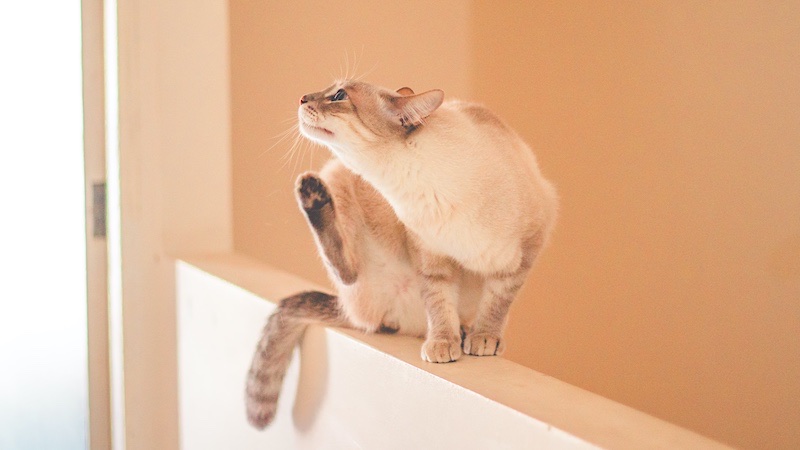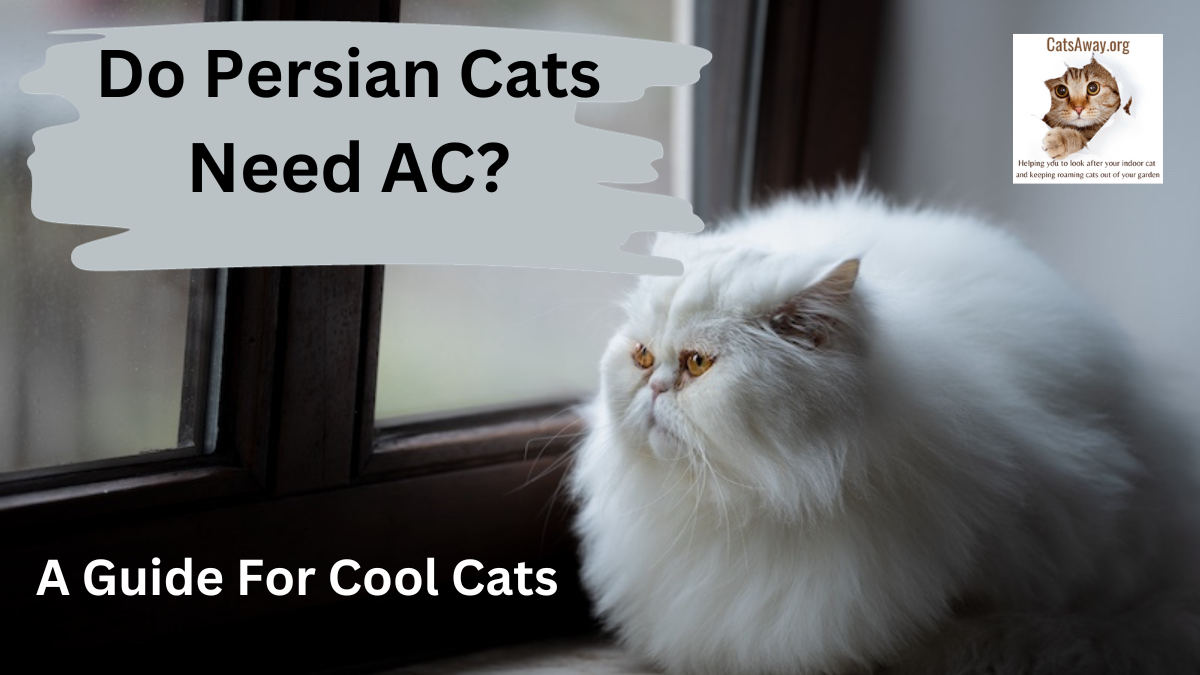As a responsible indoor cat owner who’s just discovered a flea on your beloved pet, right now you’re most likely wondering how does an indoor cat get fleas? Although it seems unlikely, there are actually several ways your cat may come into contact with these pesky parasites.
In this article, we’ll explore some of the most common ways indoor cats can get fleas and what you can do to prevent it. Understanding how indoor cats get fleas is the first step to keeping your pet happy and healthy.
How Indoor Cats Get Fleas

Contact with Other Animals
If your indoor cats encounters other animals with fleas, they might pick up the unwanted hitchhikers. Be cautious when introducing any new pets to your home and make sure they’re treated for fleas.
If you use an outdoor cat enclosure to give your pet some outdoor time, ensure any surrounding grass and other plant life doesn’t become overgrown. If they have a hideaway box inside the cattery, change the bedding regularly.
Be extra cautious after using a boarding facility and check your cats coat for signs of eggs, larvae, flea feces and adults with a flea comb.
Hitchhiker Fleas
Adult fleas are skilled jumpers and can easily jump and cling to your clothes. A simple walk around your garden could unknowingly bring fleas in contact with your cat.
How to Tell How Bad a Flea Infestation is

It’s bad enough discovering a flea on your pet but now you have have to find out how bad the flea infection is.
Scratching and Itching
If your cat starts scratching and itching excessively, it may be a sign of an infestation. This can cause them discomfort and irritation.
Visible Fleas and Flea Dirt
During grooming or petting, you may notice small black insects or black pepper-like specks (flea dirt) in your cat’s fur. These are clear signs of fleas.
Hair Loss and Raised Bumps
An infestation may result in hair loss and raised, red bumps on your cat’s skin. This occurs due to their constant scratching and itching.
Remember to check your cat’s fur regularly, especially when grooming. Using a cat flea comb is helpful, as it has finer teeth than regular grooming tools. Keeping an eye out for these signs can help you prevent or address flea infestations in your indoor cat.
Environmental Factors
Carpet and Fabric Surfaces
Fleas can easily hide and survive in carpets and fabric surfaces. To minimize their presence, you should regularly clean and vacuum your carpets, rugs, and timber floors. Vacuuming consistently is crucial as it can help in removing flea eggs, larvae, and pupae from your living space.
Make sure to wash your cat’s bedding frequently, as well as any blankets and linens they come in contact with, using hot water. This will help eliminate any flea infestation that might have started there.
Rodents and Wildlife Exposure
Sometimes, fleas can enter your home via a mouse or rat problem. Keep an eye out for any evidence of rodent activity and address it promptly.
Your indoor cat could be exposed to fleas through contact with neighborhood pets or wild animals such as raccoons, rabbits, opossums, or birds. While your indoor cats may not be venturing outside, fleas can still hitch a ride on your clothing and find their way indoors.
If you live in an apartment complex, it’s also possible for fleas to travel from one unit to another.
Remember to stay vigilant about keeping both your home and your cat as flea-free as possible. Regularly grooming your cat and using preventative treatments can help safeguard them from any unwanted flea encounters.
Preventing Flea Infestations
Regular Grooming
Groom your indoor cat frequently to detect any fleas early on. Use a flea comb, which helps in discovering and removing fleas and their eggs from your cat’s fur.
Flea Preventatives
Apply veterinarian-approved preventatives like Seresto, Beloved and Advantage for your indoor cats regularly. This not only protects your cats but helps prevent infestations in your home.
Maintaining a Clean Environment
Keep your living space clean to eliminate any favorable conditions for fleas to thrive. Vacuum your carpets, rugs, and floors regularly. Empty the vacuum canister or replace the dust bag frequently to avoid flea reinfestation. By maintaining a clean environment, you reduce the chances of fleas finding their way to your indoor cat.
Flea Treatment Options
Cat Flea Collars
Long-lasting flea collar kills & repels fleas for 8 continuous months. Seresto is the #1 selling non-prescription fleas, stocked by 8,000 vet clinics.
Starts working within 24 hours to kill & repel fleas by contact so fleas and ticks don’t have to bite your cat to die.
Cat flea collars such as the one above by Seresto provide a double layer of protection as they will both kill any existing fleas and then repel any others from jumping on and infesting your cat.
A flea collar is the recommended treatment as it’s a set and forget solution plus there are other safety benefits for an indoor cat to wear a collar.
Topical Solutions
Works within 12 hours and lasts for 1 month. It's fragrant free but only waterproof after 24 hours so only suitable for indoor cats.
Available for all cat sizes
Topical flea treatments are typically applied directly onto your cat’s skin and are ideal if your cat won’t wear a collar. The most popular veterinarian-approved option is Advantage Multi.
When applying a topical solution, make sure to follow the instructions carefully to ensure maximum effectiveness.
Oral Treatments
Oral flea treatment can be tricky as you have to get your pet to swallow the pill. These treats from Beloved get around this problem by making the pill a chewable treat for your cat.
These treatments are usually given to your cat in the form of a pill or chewable tablet. Always administer the medication as directed by the instructions.
In addition to these treatments, take extra care to clean your cat’s bedding and living areas. Vacuum carpets and floors frequently to remove fleas and their eggs. Also, consider using a flea comb to remove any remaining fleas on your cat.
Remember, the key to managing a flea infestation is a combination of treatments and diligent cleaning.
Health Concerns and Complications
Anemia and Dermatitis
Your indoor cat can develop anemia from flea infestations. This occurs when numerous fleas ingest their blood, leading to weakness, pale gums, and lethargy. In some cases, anemia can cause rapid breathing.
Fleas can also cause skin dermatitis, which results in itchy skin, hair loss, and red bites on cats and their human caretakers.
Infections and Diseases
Fleas carry diseases and parasites that can affect indoor cats. One of these parasites is the tapeworm, Dipylidium, which is commonly found in cats exposed to fleas. Tapeworms can be easily treated but you may have to quarantine a cat with tapeworms to prevent them spreading.
Be aware that fleas can transmit infections like Bartonellosis (cat scratch disease) not only to your cat but to humans as well. This bacterial infection can have various effects on both felines and people, and precautions should be taken when dealing with fleas.
Protecting All Pets in the Home
To help prevent fleas, use veterinarian-approved flea collars for all pets in the home. Using these preventatives will help keep your pets safe from an infestation.
Another vital aspect of prevention is maintaining a clean environment. Be sure to clean your yard, keeping your grass areas cut to avoid attracting fleas and ticks. Regularly vacuum your home to remove any fleas, flea eggs, and larvae from carpets and floors that you may have brought in via your garden.
In conclusion, protection of all pets in your house starts with you. Keep a clean environment and use veterinarian-approved flea collars to keep your pets, including your cat, safe from fleas and other parasites.
Conclusion
Fleas can be a nuisance, but don’t worry, their presence on your house cat doesn’t mean you’re doing something wrong. They can make their way in via various methods such as hitching a ride in on your clothes or perhaps from the neighbor who’s cat is infested and she’s called in a for a morning coffee.
Protecting your cat is essential. Make sure to keep your environment clean by vacuuming carpets and washing pet bedding.
Be vigilant against infestation
Maintain a clean home environment
By following these steps, you’ll greatly reduce the risk of fleas invading your home and keep your cat happy, healthy, and parasite-free. Enjoy quality time with your feline companion without the worry of unwanted pests.









